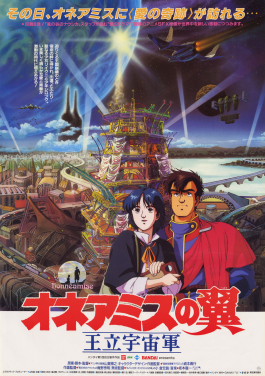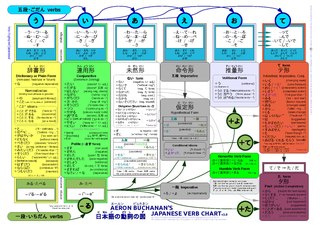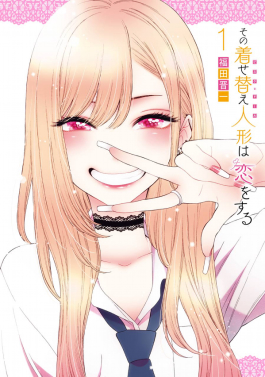Related Research Articles
Japanese is an agglutinative, synthetic, mora-timed language with simple phonotactics, a pure vowel system, phonemic vowel and consonant length, and a lexically significant pitch-accent. Word order is normally subject–object–verb with particles marking the grammatical function of words, and sentence structure is topic–comment. Its phrases are exclusively head-final and compound sentences are exclusively left-branching. Sentence-final particles are used to add emotional or emphatic impact, or make questions. Nouns have no grammatical number or gender, and there are no articles. Verbs are conjugated, primarily for tense and voice, but not person. Japanese adjectives are also conjugated. Japanese has a complex system of honorifics with verb forms and vocabulary to indicate the relative status of the speaker, the listener, and persons mentioned.

Royal Space Force: The Wings of Honnêamise is a 1987 Japanese animated science fiction film written and directed by Hiroyuki Yamaga, co-produced by Hiroaki Inoue and Hiroyuki Sueyoshi, and planned by Toshio Okada and Shigeru Watanabe. Ryuichi Sakamoto, later to share the Academy Award for the soundtrack to The Last Emperor, served as music director. The film's story takes place on an alternate world where a disengaged young man, Shirotsugh, inspired by an idealistic woman named Riquinni, volunteers to become the first astronaut, a decision that draws them into both public and personal conflict. The film was the debut work of anime studio Gainax, whose later television and movie series Neon Genesis Evangelion would achieve international recognition, and was the first anime produced by toy and game manufacturer Bandai, eventually to become one of Japan's top anime video companies.

Japanese verbs, like the verbs of many other languages, can be morphologically modified to change their meaning or grammatical function – a process known as conjugation. In Japanese, the beginning of a word is preserved during conjugation, while the ending of the word is altered in some way to change the meaning. Japanese verb conjugations are independent of person, number and gender ; the conjugated forms can express meanings such as negation, present and past tense, volition, passive voice, causation, imperative and conditional mood, and ability. There are also special forms for conjunction with other verbs, and for combination with particles for additional meanings.
This article deals with Japanese equivalents of English adjectives.

The Mobile Sheriff Jiban is a Japanese tokusatsu television series which serves as the 8th entry in the Metal Hero Series franchise, and the first entry in the Heisei period. Produced by Toei and aired by TV Asahi in Japan from January 29, 1989, to January 28, 1990, it ran for 52 episodes and a feature movie released on July 15, 1989. According to Toei's International Sales & Promotion Department, the series' English title can be referred to as Jiban.
The Japanese language has different ways of expressing the possessive relation. There are several "verbal possessive" forms based on verbs with the sense of "to possess" or "to have" or "to own". An alternative is the use of the particle no (の) between two nouns or noun phrases.
Baito keigo, is a controversial form of honorifics (keigo) in the Japanese language taught via employee training manuals, especially to young part-timers (バイト) at fast-food restaurants and convenience stores. Baito keigo incorporates nonstandard formulas for servers and cashiers to use when addressing customers, commonly longer and vaguer than the standard expression in an attempt to increase the level of politeness and avoid offense. Baito keigo is opposed by language purists on the grounds that their use frequently leads to grammatically incorrect or illogical constructions.
Gō Ikeyamada is a Japanese manga artist. She made her debut in 2002 with Get Love!!, which was serialized in Shōjo Comic.
Japanese verb conjugation is very regular, as is usual for an agglutinative language, but there are a number of exceptions. The best-known irregular verbs are the common verbs する suru "do" and 来る kuru "come", sometimes categorized as the two Group 3 verbs. As these are the only verbs frequently flagged as significantly irregular, they are sometimes misunderstood to be the only irregular verbs in Japanese. However, there are about a dozen irregular verbs in Japanese, depending on how one counts. The other irregular verbs encountered at the beginning level are ある aru "be (inanimate)" and 行く iku/yuku "go", with the copula behaving similarly to an irregular verb.
Hitoma Iruma is a Japanese writer and light novel author, best known for creating Ground Control to Psychoelectric Girl and the yuri series Adachi and Shimamura, both of which have received anime and manga adaptations. He is also known for having written Regarding Saeki Sayaka, a light novel spinoff series of Nio Nakatani's manga Bloom Into You. He was born in Gifu Prefecture.

No Game No Life is a Japanese light novel series by Yuu Kamiya. It is published under the MF Bunko J imprint with twelve novels released between April 25, 2012, and February 25, 2023. The author and his wife, Mashiro Hiiragi, adapted the novels into a manga series for Monthly Comic Alive in 2013. Later that year, an anime adaptation of No Game No Life by Madhouse was announced. It premiered on AT-X between April and July 2014, and was simulcast outside Japan by Crunchyroll. An anime film adaptation of the sixth volume, No Game, No Life Zero, premiered on July 15, 2017. A spinoff manga, No Game No Life, Please!, focusing on the character Izuna, ran from May 27, 2015, to November 27, 2017. The No Game No Life franchise was localized in North America by several companies: Seven Seas Entertainment licensed the manga, Sentai Filmworks the anime, and Yen Press the light novel series.

Yuria Kizaki is a Japanese actress and former member of the Japanese idol girl group AKB48, where she was the captain of Team B.

Uchi is the fourth studio album released by Japanese artist misono. The album charted at #49 on the Oricon charts and remained on the charts for three weeks. The full title of the album is "Uchi: ※Album ga 1man-mai Urenakattara misono wa mou CD wo Hatsubai Suru Koto ga Dekimasen." The album only sold 2,856 and misono has yet to release another single or album.

My Dress-Up Darling is a Japanese manga series written and illustrated by Shinichi Fukuda. It began serialization in Square Enix's Young Gangan in January 2018, and has been compiled in 13 volumes as of May 2024. An anime television series adaptation produced by CloverWorks aired its first season from January to March 2022. A sequel has been announced.

I Get the Feeling That Nobukuni-san Likes Me is a Japanese manga series written and illustrated by Kousuke Yasuda. It has been serialized in Hakusensha's seinen manga magazine Young Animal since September 2020.

Danjo no Yūjō wa Seiritsu Suru? is a Japanese light novel series written by Nana Nanana and illustrated by Parum. It began publication in January 2021 under ASCII Media Works' Dengeki Bunko imprint. As of April 2024, eight volumes have been released. A manga adaptation illustrated by Kamelie has been serialized in ASCII Media Works' shōnen manga magazine Dengeki Daioh since August 2021, with its chapters collected into three tankōbon volumes as of December 2023. An anime television series adaptation produced by J.C.Staff has been announced.
Royal Space Force: The Wings of Honnêamise, written and directed by Hiroyuki Yamaga, was the 1987 debut work of anime studio Gainax. While in creative terms the film was described by its executive producer, president of Bandai Makoto Yamashina, as "pure moviemaking" and having been made "without compromise", its marketing and release plans, under the advertising department of its distributor Toho-Towa, were outside the control of Gainax, and both Gainax and Yamashina acknowledged continuing clashes over these aspects; approximately half of the 800 million yen spent on the film was allocated to advertising and distribution rather than on direct production expenses.
During the production of Royal Space Force: The Wings of Honnêamise, the 1987 debut work of anime studio Gainax, the only member of its main staff known to the general public was its musical director, electronic music pioneer Ryuichi Sakamoto, who had recently overseen the soundtrack to the top Japanese box office hit of 1986, Koneko Monogatari. Sakamoto and his assistants from Koneko Monogatari, musicians Koji Ueno, Yuji Nomi, and Haruo Kubota, composed 47 pieces of background music for Royal Space Force in a process that involved using "keywords" given by film director Hiroyuki Yamaga, examining the film's storyboards, making arrangements based on early "prototype" compositions, as well as composing several new original pieces of music as the project developed. 15 of the arrangements would be featured on the film's original soundtrack album.
Gainax's 1987 debut work, the feature film Royal Space Force: The Wings of Honnêamise, was a pre-digital anime, requiring that its animation cels and background paintings be photographed onto movie film. The actual scenes in the completed work were created through this cinematographic process, involving for some shots as many as 12 different layers of cels, backgrounds, and masks designed to selectively illuminate portions of an image. Special photographic techniques were employed in multiple scenes to express particular optical or motion effects. Assistant director Shinji Higuchi, a veteran of the film crew's earlier live-action amateur works, assisted on the photography of Royal Space Force as well; Takami Akai commented that the filmmakers' live-action experience influenced their thoughts on the perspectives and compositions used in scenes, not out of an attempt to "emulate" live-action but to seek a realism in anime, a medium where "the camera doesn't really exist."
Gainax's 1987 debut work Royal Space Force: The Wings of Honnêamise was the first project on which Hiromasa Ogura served as art director; although later noted for creating much of the aesthetic behind the influential 1995 film Ghost in the Shell, Ogura himself in a 2012 interview regarded Royal Space Force as the top work of his career. Working from Yoshiyuki Sadamoto's color scheme and Takashi Watabe's architectural drawings, Ogura then gave a "a sense of life" to the aesthetics of the world setting of Royal Space Force through background paintings created by himself and a staff of 16, including future Studio Ghibli art director Yōji Takeshige, whose first work in the anime industry was on the film. The film's writer and director, Hiroyuki Yamaga, sought to avoid using what he regarded as the usual visual symbolism of anime, and instead wanted Royal Space Force's art direction to express specific times of day and night; Ogura attempted to convey Yamaga's verbal instructions in graphic form.
References
- ↑ Matthews, Peter (2003). The Concise Oxford Dictionary of Linguistics. Oxford: Oxford University Press.
- ↑ Huddleston, Rodney; Pullum, Geoffrey K. (2002). The Cambridge Grammar of the English Language. Cambridge: Cambridge University Press. p. 117.
- 1 2 3 Frana, Ilaria (2017-04-20). Modality in the nominal domain: The case of adnominal conditionals. Vol. 1. Oxford University Press. doi:10.1093/acprof:oso/9780198718208.003.0004.
- ↑ Tranter, Nicolas (2012). The Languages of Japan and Korea. Routledge. p. 293. ISBN 978-1-136-44658-0.